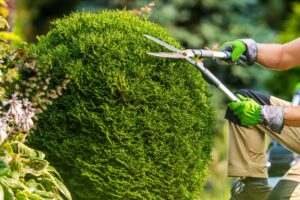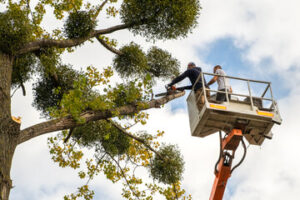Georgetown Texas Tree Service can help you manage your trees by removing dead branches, pruning overgrown trees, and fertilizing them. They also offer emergency services if your property is in danger after severe weather.
Finding a tree service with the right qualifications and insurance is important. Look for ISA certification and workers’ compensation insurance.

Professional tree surgeons are highly trained in the care and maintenance of trees. They have extensive knowledge of the intricate relationships between different species, and are able to identify and address problems within a given ecosystem. Their skills are essential in preserving and enhancing our natural environment, including biodiversity. They are also skilled in the art of pruning and removing dead, diseased or otherwise dangerous trees.
In addition to performing regular tree health checks, tree surgeons are also skilled in assessing the structural integrity of trees. This is important because a poorly maintained or damaged tree can easily fall over, causing significant damage to property and injury to individuals. This is why it is vital to hire a reputable tree service that has experienced and knowledgeable professionals on staff.
Before a tree surgeon can perform any work on your property, it is essential to find out whether they have the required credentials. Look for a company that has a good reputation and is licensed and insured. In addition, make sure that the tree surgeon is certified as an arborist or has a similar qualification from an accredited institution. Additionally, they should have years of on-the-job experience and a comprehensive understanding of the safety precautions that need to be taken when working with large trees.
Tree surgeons are equipped with modern tree cutting equipment that is safe and efficient to use around homes and backyards. They can quickly cut down large overhanging branches that block windows, driveways or roads. They also know how to remove tree stumps and clean up the site after the job is done. In this way, they help keep your home and neighborhood safer by preventing damage from falling trees.
When selecting a tree service, make sure that the company offers insurance for their workers and vehicles. This ensures that you will be compensated if any damages are caused during the course of their work. Also, look for a company that provides an accurate quote before beginning the work.
A tree is a big investment and it’s essential to find the right person to take care of it. Hiring a qualified tree surgeon is the best way to avoid costly repairs and to preserve the beauty of your home or business.
If you need emergency tree service, you should call a company that is licensed and insured. This company will send a team of arborists to your home or office to trim the trees and shrubs on your property. They will also remove unwanted branches and stumps. They can also help you select the right trees for your property, and they will provide tips on how to care for them. Additionally, they will provide you with a free estimate for the services you need.
Its professional staff has over 18 years of experience in the field. The team can assist you with trimming, shaping, and topping trees. In addition to this, they can also prune your plants and hedges. Its crews can also handle emergency storm work, and they can provide you with firewood and land clearing services.
Branches and stumps can cause accidents in your yard, so it is essential to have them removed by a reputable tree company. You should also consider hiring a company that is licensed, insured, and bonded to do this. These companies will provide a safe and effective removal service and ensure the safety of their employees and customers. They will also inspect the condition of your trees before they begin the work and offer recommendations for future care.
A family-owned tree service provides residential and commercial clients with pruning and trimming solutions. Its ISA-certified arborists will inspect your trees and create a plant health care plan that suits your needs. Its professionals can also address issues such as diseases and out-of-control growth by delivering removal, pruning, bracing, and cabling services. They can also conduct stump grinding and land clearing services.
The city maintains a 24-hour, seven-day emergency tree service. The service is available to residents and businesses in all five boroughs of . If you notice a dead tree in the street, park, or public space, report it to 311. will send an inspector to evaluate the site and determine if the tree can be saved.
Trimming services help trees grow strong and healthy by removing dead branches, encouraging new growth, and shaping the canopy. They can also remove tree limbs that are overgrown and interfering with buildings or power lines. In addition, trimming can prevent injuries and property damage during storms by removing branches that could fall and cause damage or injury. A professional tree service will have the proper equipment and safety protocols to perform this task safely and efficiently.
The cost of tree trimming services can vary depending on the size and type of tree, as well as the level of pruning required. Smaller trees are usually less expensive to trim than larger ones because they have fewer branches. However, it’s important to consider the overall health of the tree and the desired outcome of the trimming project when determining an estimate. For example, a tree that requires more extensive pruning may require a higher price because it may need to be removed entirely or partially.
Choosing a tree service that has experience and expertise in performing this type of work can save you money and time in the long run. You should always compare multiple quotes to find the best price without sacrificing quality work. It’s also a good idea to choose a company with a strong reputation and positive customer reviews.
The location of the property and the complexity of the job also play a role in the cost of trimming services. For example, trees in rural areas are often more challenging to access than those in urban neighborhoods. In addition, larger trees typically produce more debris than smaller ones, which can increase cleanup costs.
Another factor to consider is whether or not the client wants to add extra services to the initial trim, such as fungus removal or pest control. These services can add up quickly and should be included in the initial quote. In addition, it’s important to include any additional costs related to hauling debris into the estimate. This can be especially costly for customers with large quantities of waste.
When dealing with pests, tree service companies have the right product solutions to get rid of them without harming your plants. They can also expunge invasive evergreens like the spruce budworm and pine beetle to prevent them from spreading to other greeneries in your neighborhood. This can be an important part of maintaining a beautiful garden or property.
When looking for a company to perform pest extermination, make sure they have the proper credentials and certifications. They should also be licensed and insured. This will help you in the event of any problems during or after the service. Also, they should be professional and prompt. They should show up at the agreed upon time and, if they’re running late, be sure to let you know so that you can reschedule your appointment.
In addition to pest control, a reputable tree service will offer maintenance services for both trees and shrubs. This will include watering, trimming the leaves, getting rid of pests, and treating diseases. This will ensure that your trees stay healthy and that they can thrive on your property.
Choosing a reputable tree service can save you a lot of money in the long run. You can expect them to do a thorough job and keep your trees and shrubs in tip-top shape. They will also provide you with valuable advice about the prosperity of your plants and how to maintain them properly. They will also do a thorough inspection of your property to reduce risks and improve safety.


